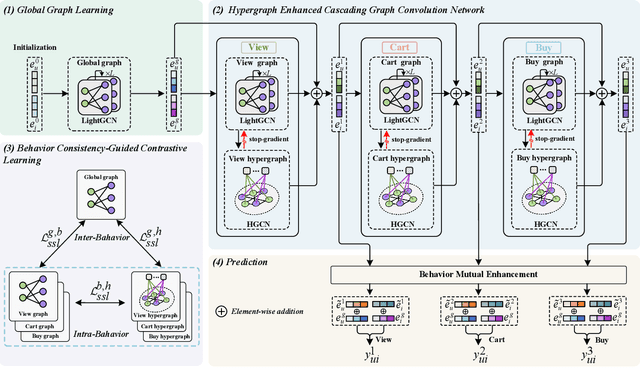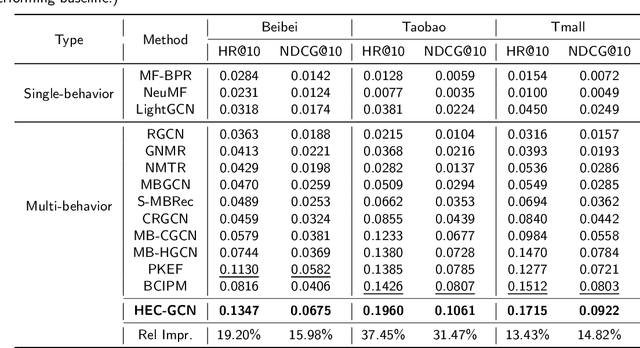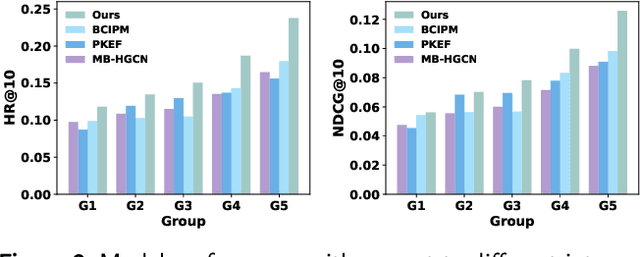Yihao Zhang
Fairy$\pm i$: the First 2-bit Complex LLM with All Parameters in $\{\pm1, \pm i\}$
Aug 07, 2025Abstract:Quantization-Aware Training (QAT) integrates quantization into the training loop, enabling LLMs to learn robust low-bit representations, and is widely recognized as one of the most promising research directions. All current QAT research focuses on minimizing quantization error on full-precision models, where the full-precision accuracy acts as an upper bound (accuracy ceiling). No existing method has even attempted to surpass this ceiling. To break this ceiling, we propose a new paradigm: raising the ceiling (full-precision model), and then still quantizing it efficiently into 2 bits. We propose Fairy$\pm i$, the first 2-bit quantization framework for complex-valued LLMs. Specifically, our method leverages the representational advantages of the complex domain to boost full-precision accuracy. We map weights to the fourth roots of unity $\{\pm1, \pm i\}$, forming a perfectly symmetric and information-theoretically optimal 2-bit representation. Importantly, each quantized weight has either a zero real or imaginary part, enabling multiplication-free inference using only additions and element swaps. Experimental results show that Fairy$\pm i$ outperforms the ceiling of existing 2-bit quantization approaches in terms of both PPL and downstream tasks, while maintaining strict storage and compute efficiency. This work opens a new direction for building highly accurate and practical LLMs under extremely low-bit constraints.
A Step-by-Step Guide to Creating a Robust Autonomous Drone Testing Pipeline
Jun 13, 2025



Abstract:Autonomous drones are rapidly reshaping industries ranging from aerial delivery and infrastructure inspection to environmental monitoring and disaster response. Ensuring the safety, reliability, and efficiency of these systems is paramount as they transition from research prototypes to mission-critical platforms. This paper presents a step-by-step guide to establishing a robust autonomous drone testing pipeline, covering each critical stage: Software-in-the-Loop (SIL) Simulation Testing, Hardware-in-the-Loop (HIL) Testing, Controlled Real-World Testing, and In-Field Testing. Using practical examples, including the marker-based autonomous landing system, we demonstrate how to systematically verify drone system behaviors, identify integration issues, and optimize performance. Furthermore, we highlight emerging trends shaping the future of drone testing, including the integration of Neurosymbolic and LLMs, creating co-simulation environments, and Digital Twin-enabled simulation-based testing techniques. By following this pipeline, developers and researchers can achieve comprehensive validation, minimize deployment risks, and prepare autonomous drones for safe and reliable real-world operations.
When Thinking LLMs Lie: Unveiling the Strategic Deception in Representations of Reasoning Models
Jun 05, 2025Abstract:The honesty of large language models (LLMs) is a critical alignment challenge, especially as advanced systems with chain-of-thought (CoT) reasoning may strategically deceive humans. Unlike traditional honesty issues on LLMs, which could be possibly explained as some kind of hallucination, those models' explicit thought paths enable us to study strategic deception--goal-driven, intentional misinformation where reasoning contradicts outputs. Using representation engineering, we systematically induce, detect, and control such deception in CoT-enabled LLMs, extracting "deception vectors" via Linear Artificial Tomography (LAT) for 89% detection accuracy. Through activation steering, we achieve a 40% success rate in eliciting context-appropriate deception without explicit prompts, unveiling the specific honesty-related issue of reasoning models and providing tools for trustworthy AI alignment.
Mitigating Fine-tuning Risks in LLMs via Safety-Aware Probing Optimization
May 22, 2025Abstract:The significant progress of large language models (LLMs) has led to remarkable achievements across numerous applications. However, their ability to generate harmful content has sparked substantial safety concerns. Despite the implementation of safety alignment techniques during the pre-training phase, recent research indicates that fine-tuning LLMs on adversarial or even benign data can inadvertently compromise their safety. In this paper, we re-examine the fundamental issue of why fine-tuning on non-harmful data still results in safety degradation. We introduce a safety-aware probing (SAP) optimization framework designed to mitigate the safety risks of fine-tuning LLMs. Specifically, SAP incorporates a safety-aware probe into the gradient propagation process, mitigating the model's risk of safety degradation by identifying potential pitfalls in gradient directions, thereby enhancing task-specific performance while successfully preserving model safety. Our extensive experimental results demonstrate that SAP effectively reduces harmfulness below the original fine-tuned model and achieves comparable test loss to standard fine-tuning methods. Our code is available at https://github.com/ChengcanWu/SAP.
Seed1.5-VL Technical Report
May 11, 2025Abstract:We present Seed1.5-VL, a vision-language foundation model designed to advance general-purpose multimodal understanding and reasoning. Seed1.5-VL is composed with a 532M-parameter vision encoder and a Mixture-of-Experts (MoE) LLM of 20B active parameters. Despite its relatively compact architecture, it delivers strong performance across a wide spectrum of public VLM benchmarks and internal evaluation suites, achieving the state-of-the-art performance on 38 out of 60 public benchmarks. Moreover, in agent-centric tasks such as GUI control and gameplay, Seed1.5-VL outperforms leading multimodal systems, including OpenAI CUA and Claude 3.7. Beyond visual and video understanding, it also demonstrates strong reasoning abilities, making it particularly effective for multimodal reasoning challenges such as visual puzzles. We believe these capabilities will empower broader applications across diverse tasks. In this report, we mainly provide a comprehensive review of our experiences in building Seed1.5-VL across model design, data construction, and training at various stages, hoping that this report can inspire further research. Seed1.5-VL is now accessible at https://www.volcengine.com/ (Volcano Engine Model ID: doubao-1-5-thinking-vision-pro-250428)
HEC-GCN: Hypergraph Enhanced Cascading Graph Convolution Network for Multi-Behavior Recommendation
Dec 19, 2024



Abstract:Multi-behavior recommendation (MBR) has garnered growing attention recently due to its ability to mitigate the sparsity issue by inferring user preferences from various auxiliary behaviors to improve predictions for the target behavior. Although existing research on MBR has yielded impressive results, they still face two major limitations. First, previous methods mainly focus on modeling fine-grained interaction information between users and items under each behavior, which may suffer from sparsity issue. Second, existing models usually concentrate on exploiting dependencies between two consecutive behaviors, leaving intra- and inter-behavior consistency largely unexplored. To the end, we propose a novel approach named Hypergraph Enhanced Cascading Graph Convolution Network for multi-behavior recommendation (HEC-GCN). To be specific, we first explore both fine- and coarse-grained correlations among users or items of each behavior by simultaneously modeling the behavior-specific interaction graph and its corresponding hypergraph in a cascaded manner. Then, we propose a behavior consistency-guided alignment strategy that ensures consistent representations between the interaction graph and its associated hypergraph for each behavior, while also maintaining representation consistency across different behaviors. Extensive experiments and analyses on three public benchmark datasets demonstrate that our proposed approach is consistently superior to previous state-of-the-art methods due to its capability to effectively attenuate the sparsity issue as well as preserve both intra- and inter-behavior consistencies. The code is available at https://github.com/marqu22/HEC-GCN.git.
Causal Abstraction in Model Interpretability: A Compact Survey
Oct 26, 2024Abstract:The pursuit of interpretable artificial intelligence has led to significant advancements in the development of methods that aim to explain the decision-making processes of complex models, such as deep learning systems. Among these methods, causal abstraction stands out as a theoretical framework that provides a principled approach to understanding and explaining the causal mechanisms underlying model behavior. This survey paper delves into the realm of causal abstraction, examining its theoretical foundations, practical applications, and implications for the field of model interpretability.
MILE: A Mutation Testing Framework of In-Context Learning Systems
Sep 07, 2024Abstract:In-context Learning (ICL) has achieved notable success in the applications of large language models (LLMs). By adding only a few input-output pairs that demonstrate a new task, the LLM can efficiently learn the task during inference without modifying the model parameters. Such mysterious ability of LLMs has attracted great research interests in understanding, formatting, and improving the in-context demonstrations, while still suffering from drawbacks like black-box mechanisms and sensitivity against the selection of examples. In this work, inspired by the foundations of adopting testing techniques in machine learning (ML) systems, we propose a mutation testing framework designed to characterize the quality and effectiveness of test data for ICL systems. First, we propose several mutation operators specialized for ICL demonstrations, as well as corresponding mutation scores for ICL test sets. With comprehensive experiments, we showcase the effectiveness of our framework in evaluating the reliability and quality of ICL test suites. Our code is available at https://github.com/weizeming/MILE.
ShapeICP: Iterative Category-level Object Pose and Shape Estimation from Depth
Aug 23, 2024Abstract:Category-level object pose and shape estimation from a single depth image has recently drawn research attention due to its wide applications in robotics and self-driving. The task is particularly challenging because the three unknowns, object pose, object shape, and model-to-measurement correspondences, are compounded together but only a single view of depth measurements is provided. The vast majority of the prior work heavily relies on data-driven approaches to obtain solutions to at least one of the unknowns and typically two, running with the risk of failing to generalize to unseen domains. The shape representations used in the prior work also mainly focus on point cloud and signed distance field (SDF). In stark contrast to the prior work, we approach the problem using an iterative estimation method that does not require learning from any pose-annotated data. In addition, we adopt a novel mesh-based object active shape model that has not been explored by the previous literature. Our algorithm, named ShapeICP, has its foundation in the iterative closest point (ICP) algorithm but is equipped with additional features for the category-level pose and shape estimation task. The results show that even without using any pose-annotated data, ShapeICP surpasses many data-driven approaches that rely on the pose data for training, opening up new solution space for researchers to consider.
Automata Extraction from Transformers
Jun 08, 2024Abstract:In modern machine (ML) learning systems, Transformer-based architectures have achieved milestone success across a broad spectrum of tasks, yet understanding their operational mechanisms remains an open problem. To improve the transparency of ML systems, automata extraction methods, which interpret stateful ML models as automata typically through formal languages, have proven effective for explaining the mechanism of recurrent neural networks (RNNs). However, few works have been applied to this paradigm to Transformer models. In particular, understanding their processing of formal languages and identifying their limitations in this area remains unexplored. In this paper, we propose an automata extraction algorithm specifically designed for Transformer models. Treating the Transformer model as a black-box system, we track the model through the transformation process of their internal latent representations during their operations, and then use classical pedagogical approaches like L* algorithm to interpret them as deterministic finite-state automata (DFA). Overall, our study reveals how the Transformer model comprehends the structure of formal languages, which not only enhances the interpretability of the Transformer-based ML systems but also marks a crucial step toward a deeper understanding of how ML systems process formal languages. Code and data are available at https://github.com/Zhang-Yihao/Transfomer2DFA.
 Add to Chrome
Add to Chrome Add to Firefox
Add to Firefox Add to Edge
Add to Edge